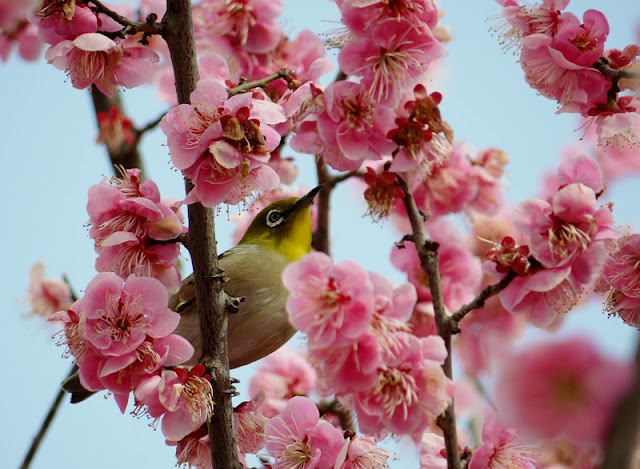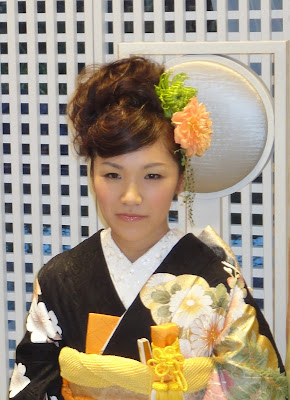There is a bird on the branch of ume (Japanese apricot) tree.
Some Japanese people might think he is a Japanese bush warbler.
Look at his eye which is barely visible among the flowers.
Now some of you would know what he is.
Now some of you would know what he is.
He is a Japanese white-eye.
He has the distinctive white eye ring, which gives its name.
Many Japanese people mistake Japanese white-eye (目白 mejiro) for Japanese bush warbler (鶯 uguisu). There has been a confusion between the two birds among the Japanese people and there are a couple of reasons for that. For one thing, 梅に鶯, Ume blossom and Japanese bush warbler, is one of certain traditional pairings of flowers and birds/animals like 松に鶴/pine tree and crane (an auspicious pair), 藤に不如帰/wisteria and cuckoo, 紅葉に鹿/maple leaves and deer, and so on.
 |
| Ume and Uguis of Hanafuda (Flower-cards) image via here |
 |
| 48 cards of Hanafuda image via here |
 |
| mejiro-colored uguisu-mochi on the uguisu-colored plate |
This is a traditional sweet “uguisu-mochi”. It is slightly oval-shaped rice cakes, sprinkled with green tea powder and filled with bean-paste, which is meant to suggest uguisu, or Japanese bush warbler. Actually, this is not the color of uguisu but that of mejiro, or Japanese white eye. The color of uguisu is closer to that of the plate.
 |
| Uguisu/Japanese bush warbler, image via here |
Japanese bush warblers are drab olive green. They are cautious and usually remain deep in the shadow of foliage in the grove.
The olive-green birds which come for the nectar of ume blossoms are Japanese white-eyes, while Japanese bush warblers come to Ume trees for insects when they are thick with foliage. Japanese white-eyes are not so cautious that are spotted out rather easily.
Ume blossoms are thought to be a harbinger of spring as they bloom much earlier than other spring plants when air is still cold. The cry of male Japanese bush warbler also heralds the arrival of spring with their distinctive chirps, Ho-Hokekyo, which is a pan to 法-法華経, the Lotus Sutra of Buddhism. People hear the chirping of a Japanese bush warbler from nowhere and see the appearance of Japanese white-eye among ume blossoms, which caused misunderstanding and confusion about the two birds.
Bush warblers and Ume blossoms have been featured in haiku as seasonal words of spring and often the motif of paintings and other arts.
song of Japanese bush warbler












































